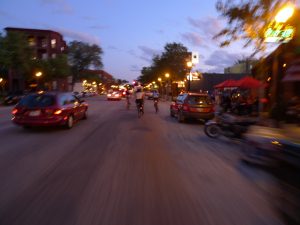
A gust of frigid winter air swirled onto my face as I stepped out of the plane door and into the Minneapolis-St. Paul airport (MSP) for the first time. MSP was all too quiet. I was used to bustling John F. Kennedy airport in New York City, with its mélange of languages, attire, and physical appearances as business travelers, tourists, and families jockeyed to get to their gates. But, step after step, I saw a sea of White. Quickening my step, I looked around instinctually for glimpses of anyone with a darker skin tone. As a mixed Black woman, this was certainly not my first time in predominantly White spaces. However, I wasn’t expecting to stand out at an international airport. Arriving in Minneapolis after acceptance into the University of Minnesota doctoral program in American Studies, I arrived for a prospective student visit. At first, I thought, there is no way I am coming here despite the department’s reputation with cutting edge race and gender research. It wasn’t just the cold. I liked ice skating and cross-country skiing after all! My preconceived notions of Minnesota narrowed my mindset to a crockpot cuisine, Mall of America, flannel-attired White land. But, I would soon give Minnesota a chance. University of Minnesota American Studies department’s Mas(s) Color group for graduate students of color members and student coordinators were unbelievably responsive and honest. The MacArthur Fellowship program offered an opportunity to learn alongside other graduate students and faculty in other fields working on social change in the global South. I thought, at worst, these would be havens, and Minnesota is a blue state after all.
At the same time, I cared a lot about having a community away from academia. I only had applied to graduate school in big cities. I also thought, well if I’m getting a doctorate in American Studies, I need to learn about the rest of the United States aside from the coasts. I knew that the American Indian Movement started in Minneapolis. I figured since Prince is from here and Janet Jackson lived here for a while, there must be more to check out. But I began to realize that I had erased BIPOC communities from Minnesota narratives and imagery. The first step entailed a road trip from NYC to Minneapolis. With Paul Bunyan statues, beautiful lakes, and lots of stares at gas stations, would Minneapolis be an oasis?Driving into Uptown, my new home, I passed crowds in front of Chino Latino, a trendy restaurant marketing “hot zone street food” with the logo of a masculine face fused with racially caricatured “Chino” and “Latino” top and bottom halves. This gesture towards a consumption of the “Other” characterized many of my later Minneapolis experiences. Growing up in an interracial family with an African American mother and a white father in 1980s Brooklyn, NY, I didn’t know many other families like mine. But, my appearance didn’t stand out. If anything, I was assumed to be Nuyorican, a member of the Puerto Rican diaspora in New York City. In other parts of the city, I might be misidentified as Filipino. Although many New York City neighborhoods are quite segregated, my place in diverse, multicultural New York City was never questioned. Here in Minneapolis, I often felt out of my place as “Other.” My racial ambiguity triggered discomfort masked as curiosity. The couched innocence of “Where are you from?” became more insistent when my answers shrouding racial categorization did not suffice. Follow-up questions of “No, I mean what country are you from?” “Where are your parents from?” and “You can’t be American, what are you?” cascaded. “Wow, that’s an exotic look,” or a worried sounding “Oh,” and then a quick scurrying away if I chose to announce my Black identity. In other corners when asked by BIPOC members of the Twin Cities, the questions were not to police my place in Minnesota. Instead, the questions such as “Who are your people?” were often phrased as a means of connection.

Over and over again, Minnesotans praised Minneapolis for its progressiveness and inclusion. Yet, this inclusion centered on who was deemed palatable and acceptable. Comments such as “We don’t have much racism here because there aren’t many African Americans” negates the continuing presence of African Americans, from the hauntings of Dred Scott to the segregation of neighborhoods such as North Minneapolis.
Bit by bit, I found welcoming Minnesotans and transplanted communities unbound by Minnesota standoffish friendliness. At multigenerational house parties imbued with salsa, samba, and hip hop or at dinner gatherings, I would meet one person and often receive another added invitation with a nod to being “like one of us.” In spaces and performances such as Intermedia Arts, EQ at the Loft, Mixed Blood Theater, Ananya Dance Theatre, and Penumbra Theater, the immense solidarity for celebrating and supporting BIPOC performers was palpable. In many ways, I found that the racial dynamics of Minnesota generated a sense of shared fate, purpose, and support among BIPOC communities that I have not found in larger urban areas. This is not to say that there weren’t tensions regarding alliance commitments, however.
The American Studies department had many activist scholars and I chose the department for its centering of race, gender, and sexuality, decolonial lens, and a critical grappling with “America.” The transnational focus alongside Indigenous perspectives, knowledge, and resistance especially fomented my understanding of racial formations, Blackness, and white supremacy in the Americas. But, the semester I entered the department, Mas(s) Color was defunded. In other classes, I found White graduate students red in the face with clenched teeth and yelling at Black female professors over what was criticized as an overemphasis on race in the department. In some discussions in other departments, White students commented on my aggressive nature. In typical New York City fashion, I thought aggressive was a compliment and did not realize this was a supreme White, Minnesota nice, racialized insult. Some faculty members and students insisted that my research on mixed Blackness and racism was not relevant anymore because of Barack Obama’s successful presidential campaign. Another faculty member suggested that I work with first-generation undergraduate students because I spoke English like a “native speaker.” Thankfully, faculty members like that were in the minority. Overall, my advisors and faculty mentors were overwhelmingly supportive of my intellectual journeys. Even still, where were the Black graduate students? While I had attended predominantly White educational institutions in Massachusetts, there were already pre-existing networks of Black students there. Eventually, in Rose Brewer’s “Intellectual History of Race” course in the African and African Diaspora Studies graduate minor program, I met a few other African American students from other departments. “Why had we not met before and where have you been this whole time?” we exclaimed to each other. Sarah Janel Jackson generated the idea to start the University of Minnesota Black Graduate Students Association in 2008 and I soon came on board as Vice President and then President. We wanted to create a sense of Black community at the university and support each other, combat isolation, and engage with the broader Twin Cities BIPOC communities.Living in Minnesota was critical to my intellectual formation and sense of solidarity and community. I was lucky enough to find an Assistant Professor position in American Studies at the State University of New York-Old Westbury and return to reside in New York City. New York City will always be my home and its skyline still takes my breath away every single time, but the New York City I returned home to has become increasingly gentrified and stratified along racial and class lines. Minneapolis became one of my favorite world cities—the beautiful lakes and river with amazing arts, the relative affordability to New York City, the neighborhood communities. However, neither the murders of Philando Castile and George Floyd and countless others nor the violence inflicted upon protesters surprises me. The Minnesota nice comforts and illusionary progressiveness resides upon the ignoring of White racial terrorism and fears of Blackness, brown immigrants, and resistance to White supremacy. Minneapolis, like other cities including my hometown, pride themselves on liberalism and often include themselves as exceptional. Minneapolis is not exceptional but rather exemplifies the willingness to negate racism. The seeds of my book, Imagining the Mulatta: Blackness in U.S. and Brazilian Media germinated in Minneapolis as I saw contradictions of illusionary racial progress, the denial of racism, and enduring legacies of slavery and colonization. Nonetheless, I remain inspired by the amazing movements that have sprung up since the tragic murders and the newfound solidarity between communities they inspired. I hope Minneapolis will never be the same, that our nation will never be the same, the world will never be the same.
New York, NY
July 14, 2020
Previous Reflection Next Reflection
Return to the Wonderful/Wretched Series introduction.
